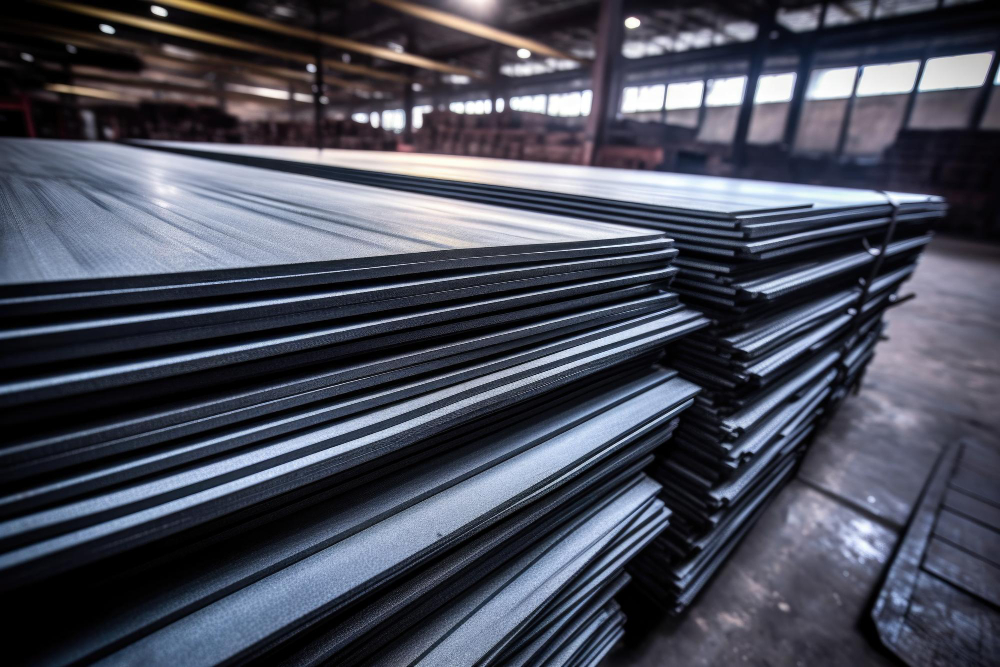
If you’ve ever marveled at the towering skyline of a bustling city or the sweeping expanse of a sturdy bridge, you may not have considered the hidden elements that make these structures possible. Deep within the earth, piles are the unsung foundation that ensures the longevity and safety of construction projects. From towering skyscrapers to residential homes, piles support structures in a variety of soil conditions. Here, we’ll learn the various types of piles and their construction methods, concluding with insights from leading sheet pile manufacturers.
What Does Piling Entail in Modern Construction?
Piling is a foundational technique that involves embedding piles deep into the earth beneath a construction site. These piles act as sturdy columns, carrying the load of the structure above to stronger soil layers below. This method is particularly crucial in areas where the surface soil lacks the strength to support a structure on its own.
What Constitutes a Pile Foundation?
Pile foundations are elongated, sturdy columns typically crafted from steel or reinforced concrete. They are driven deep into the ground to reach and rest on dense, compact soil or rock strata. By bypassing weaker, softer layers closer to the surface, they provide a reliable and robust base for construction.
Where Did the Practice of Piling Originate?
The genesis of piling traces back to the necessities of ancient civilizations, who sought stable constructions near water bodies. Around 6000 years ago, inhabitants of what is now Switzerland constructed elevated homes on piles to protect against floods. Similarly, the Romans pioneered the use of timber piles for maritime and bridge construction across Europe, including in the UK, where timber piles were used for bridges over 2000 years ago.
This early ingenuity arose from the need to stabilize buildings in marshy or unstable soil, a challenge that persists in modern construction. The practice has evolved from manually driven timber piles to sophisticated piling systems, addressing the modern demands for infrastructure and development on less-than-ideal lands.
What Are the Different Types of Piles Used in Construction?
Piling, a crucial aspect of building strong foundations, primarily utilizes two distinct types: end-bearing piles and friction piles.
End-Bearing Piles: These piles are designed to reach a solid layer of soil or rock that lies deep beneath the surface layers. By doing so, they effectively transmit the structural loads directly to this sturdy layer, ensuring stability and support for the structure above.
Friction Piles: Unlike end-bearing piles, friction piles work by creating resistance along the length of the pile through the interaction between the pile’s surface and the surrounding soil. This method leverages the frictional force to bear the load.
How Are Different Types of Pile Foundations Constructed?
Understanding the distinction between a pile and a pile foundation is essential for grasping their functionalities in construction. A pile foundation comprises a network of columns that serve as the structural base, whereas a pile is an individual column-like structure that transfers the load deeper into the soil.
Driven Piles- A Time-Tested Method
Driven piles are a traditional piling technique using materials like timber, concrete, and steel. Historically, timber has been used for piling in coastal and marine constructions in places like the UK, where it supports jetties and sea defenses. Concrete piles, often precast in square or octagonal shapes, are reinforced to endure the stresses of driving. Steel piles, available in tubular, box, or H-sections, are also popular, especially interlocking steel sheet piles crafted by sheet pile manufacturers for wall construction.
This method involves driving the piles into the ground, displacing soil around the pile and enhancing the ground’s load-bearing capacity. However, driven piles are less suitable for saturated or silty soils due to their slow drainage, which does not allow for effective soil compaction.
Bored Piles- Modern Foundations for Complex Loads
Bored piles, also known as drilled or replacement piles, are created by excavating a hole in the ground and filling it with concrete. These piles are excellent for transferring loads to deeper, more stable soil layers, making them ideal for significant structures like bridges and for flood defense mechanisms.
In some cases, the lower section of the hole is expanded to form a bulb, enhancing the pile’s load-bearing capacity. The construction involves placing a steel reinforcement cage within the hole, followed by concrete placement, ensuring a robust foundation.
Diverse Techniques in Bored Pile Construction
Bored pile construction varies significantly depending on the soil and environmental conditions. Two primary methods are rotary bored piling and Continuous Flight Auger (CFA) piling. Rotary bored piling is advantageous in areas with underground obstructions, using a temporary casing to maintain the borehole’s stability. In contrast, CFA piling is a quicker method where concrete is pumped into the borehole followed by the insertion of a steel cage, commonly used for its versatility and effectiveness.
Driven Piles Versus Bored Piles
The choice between driven and bored piles often hinges on the construction site’s conditions and the project’s specific requirements. Driven piles are prefabricated and quickly installed, which can be advantageous in terms of construction speed but may cause significant vibrations, making them unsuitable for compact sites. Bored piles, although slower to install, provide higher load-bearing capacities and minimal site disturbance, making them preferred in urban settings.
Innovations in Driven and Cast In-Situ Piles
Combining driven and cast-in-situ piling techniques enhances the strengths of both methods. One approach involves driving a steel casing into the ground and then filling it with concrete, creating a durable composite pile. Alternatively, the Franki piling method involves driving a temporary casing and then filling it with a dry concrete mix that compacts to form an enlarged base, improving the pile’s stability and capacity.
Utilizing Aggregate Piles
- Aggregate piles also referred to as stone columns, utilize compacted aggregate instead of concrete to form the pile foundation.
- The construction process involves:
- Inserting a casing into the ground as a hole is bored.
- Dropping aggregate into the casing in layers, which are compacted or vibrated as the casing is gradually withdrawn.
- Sideways displacement of aggregate into the surrounding soil improves bearing capacity.
- Constructed using a vibrating casing to create densely compacted gravel columns.
- The vibration densifies the surrounding granular soils.
- Aggregate is rammed into a casing, which forces the material to form a dense bulb at the base as the casing is withdrawn.
- Repeated in stages, this method densifies and strengthens the surrounding soil.
Installation Techniques for Piling
Piling rigs often mounted on tracks, are specialized equipment designed to install specific types of piles. For installing driven piles, various methods are used: percussion hammers, hydraulic drivers, or rams—particularly for sheet piles provided by sheet pile manufacturers. Diesel-powered vibratory drivers are also employed to reduce resistance from the surrounding ground, facilitating the pile’s insertion into the earth.
Bored piles are created using a continuous auger, resembling an oversized drill bit, with diameters ranging from 300mm to 900mm. For larger projects, circular bits up to 1200mm are used. These rigs, essential tools supplied by experienced sheet pile manufacturers, can weigh up to 180 tonnes, emphasizing the scale and precision required in such operations.
Pile Foundations in Bridge Construction
In bridge construction, piles are crucial for providing foundational support, especially alongside bridge abutments. The technique mirrors traditional piling methods when bridges are constructed over land. However, building over water introduces unique challenges. Sheet pile manufacturers often recommend using a cofferdam—a watertight enclosure—to facilitate pile installation. Once erected, water is pumped out, allowing a dry environment for constructing the piles.
Optimizing Safety in Piling Operations
- Piling platforms support rigs required for varying pile types and depths.
- Platforms are constructed by compacting granular fill sourced externally or from onsite demolition rubble.
- The design ensures load distribution from rig tracks, preventing bearing failures.
- Reduces settlement to maintain safe rig operation.
- Platform design requires precise engineering based on site-specific soil data and piling rig loads.
- It must be conducted by qualified engineers to ensure safety and efficacy.
- A significant number of Dangerous Occurrences in the industry relate to piling platform issues.
- Each incident or near-miss on a platform represents a potentially fatal risk.
- The principal contractor typically oversees platform design and construction.
- Designs must adhere to stringent industry standards and safety regulations.
- Platforms must be certified to confirm they meet safety design and construction standards.
- Regular inspections and maintenance are crucial for ongoing safety assurance.
- Guidelines and certifications ensure platforms are built to the highest safety standards.
- Continuous advancements in design methodologies enhance safety and operational efficiency.
- Innovations include the integration of geosynthetics in designs and advanced design software tools.
- As sheet pile manufacturers innovate in pile materials and designs, corresponding advancements in piling platform technology enhance overall project safety and integrity.
Get Started with Bigfoot Pipe And Piling Today
Ready to enhance your construction project’s foundation with top-quality sheet piles? Contact Bigfoot Pipe And Piling, your expert sheet pile manufacturer. We provide robust piling solutions tailored to your specific needs. Ensure your project stands on solid ground—reach out to us now and see how our expertise can make a difference in your construction success.

